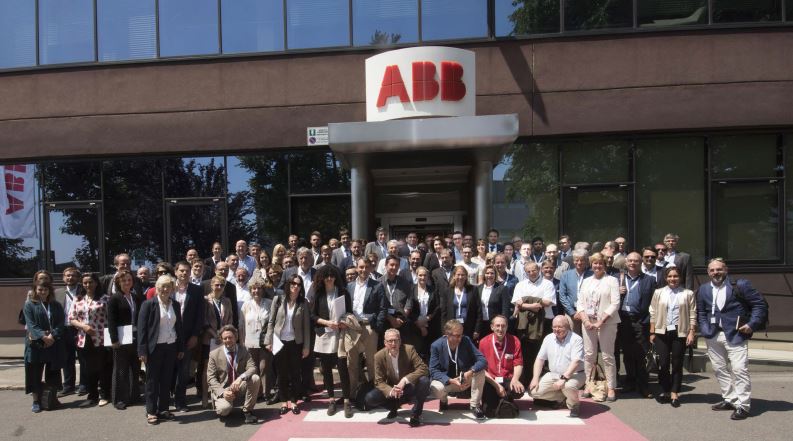Switzerland’s ABB has this week unveiled details of a suite of new solar inverters designed to broaden its portfolio and augment its pivot towards greater digitalization across all of its business segments.
The power electronics firm, which makes PV inverters and batteries for the solar industry, is expanding its ABB Ability portfolio – which comprises software-enabled solutions and IP-connected products and services that plug into the Internet of Things (IoT).
Tangibly, this equates to three new inverter products set to be officially launched at the Intersolar Europe exhibition in Munich at the end of this month. For the growing commercial and industrial (C&I) space, ABB has produced new 100 kW and 120 kW three-phase string inverters that feature multi-MPPT to encourage greater uptake in ground-mounted solutions.
These 1,000 Vdc inverters will be available at the end of 2017, with 1,500 Vdc versions coming in early 2018, ABB’s global strategic marketing and business development manager for renewable energy products Tommaso Landi told pv magazine at a press event held in Dalmine, Italy, the site of ABB’s Smart Lab.
“ABB is introducing six new solar products this year, and more in 2018 as part of the ABB Ability digitalization of our portfolio,” added ABB’s head of global marketing, solar, Alireza Mehrtash. Joining the three-phase string inverters will be a new 50-60 kW TRIO TM, which has three-MPPT and has been designed to enable greater energy harvest of larger solar systems up to 5 MW, while at the residential scale the new UNO-DM-PLUS series has a compact design and power ratings in the range of 1.2 to 5 kW, which will enable integration with existing and future smart home devices such as storage and electric vehicle charging stations.
pv magazine asked Mehrtash if ABB has any plans to enter the module-level power electronics (MLPE) space in the near future, to add further weight to the firm’s burgeoning PV portfolio. “We have had discusssions about this possibility very recently actually,” he said. “We never reject any technology, and right now all I can say is that we are discussing all opportunities and all markets.”
ABB also showcased details of its new microgrid solution, the MGS100, which has been designed to operate as a standalone microgrid or to plug into larger grids as and when the need arises. “The MGS100 enables microgrids to operate off-grid, alongside weak grids, and even where there are strong grids, providing backup power support,” said Maxine Ghavi, who is ABB’s group SVP, program director for Microgrids. The MGS 100 is modular and can support solar inverters ranging from 20 kW to 60 kW, with an external battery support capability that can operate with many different types of batteries, including lead acid and lithium-ion.
“This was important because in some countries, India in particular, lithium-ion battery chemistries are still not allowed,” Ghavi said.
Towards a digital future
The ethos driving each of ABB’s new products, Landi said, was digitalization, and the way in which greater automation in the home, the IoT and a growing demand for self-consumption is driving demand for such software-enabled products and services.
“The new ABB products are very much ‘BYOD’ – which means Bring Your Own Device. So anybody with a smartphone or tablet can operate their systems easily and without friction,” Landi told pv magazine.
Earlier in the day, ABB’s president of the electrification products division Tarak Mehta, ABB CTO Bazmi Hussein, and two representatives from Microsoft delivered a detailed presentation of why, and how, ABB is taking its next steps on the digitalization journey. “It is great that things are increasingly connected, but what are we to do with that connection, with the data available?,” mused Mehta, adding that there will be 20 billion connected devices globally by 2020, by which time 35% of the world’s new cars will be electric vehicles. “The challenges and opportunities of this digital infrastructure are vast,” he said.

The ABB CTO Hussein said that the world is facing four distinct megatrends right now: an increasing embrace of renewable energy; a startling demographic shift towards urbanization; stretched natural resources, and a growing need for digitalization of even traditionally low-tech industries such as agriculture, mining and food production.
“Linking digital with analog is going to be very important over the coming years, particularly as more and more intermittent renewable energy is produced,” Hussein explained. “We have to find ways to deliver value for everybody, to handle the unpredictability of solar and wind, to store it, and to have increased automation of the consumption of power.”
By way of explanation, Hussein described some of the software solutions that form part of the ABB free@home platform, which can smartly control where, when and how a home uses solar energy, including peak shaving capabilities, storage and EV charging.
Microsoft’s presentation compared how the nature of leading Fortune 500 companies has changed in such a short space of time as digitalization has taken hold. He average lifetime of a Fortune 500 company is now just 12 years, down from 90 years in 1935, with a new entrant every eight days. “It is increasingly crowded and competitive at the top,” they said.
Digitalization can help to pioneer new ideas, with car-sharing app-based platform Uber cited as an example. “Uber’s model removes the friction of payment,” Microsoft said, which is a bigger deal than many realize. Netflix and Alibaba do likewise, they added. “These companies have risen to the top of their respective industries, all while owning no physical assets. They are just platforms, enablers. And we think any company can become a platform.”
pv magazine attended the ABB Media event as a guest of ABB.
This content is protected by copyright and may not be reused. If you want to cooperate with us and would like to reuse some of our content, please contact: editors@pv-magazine.com.



1 comment
By submitting this form you agree to pv magazine using your data for the purposes of publishing your comment.
Your personal data will only be disclosed or otherwise transmitted to third parties for the purposes of spam filtering or if this is necessary for technical maintenance of the website. Any other transfer to third parties will not take place unless this is justified on the basis of applicable data protection regulations or if pv magazine is legally obliged to do so.
You may revoke this consent at any time with effect for the future, in which case your personal data will be deleted immediately. Otherwise, your data will be deleted if pv magazine has processed your request or the purpose of data storage is fulfilled.
Further information on data privacy can be found in our Data Protection Policy.